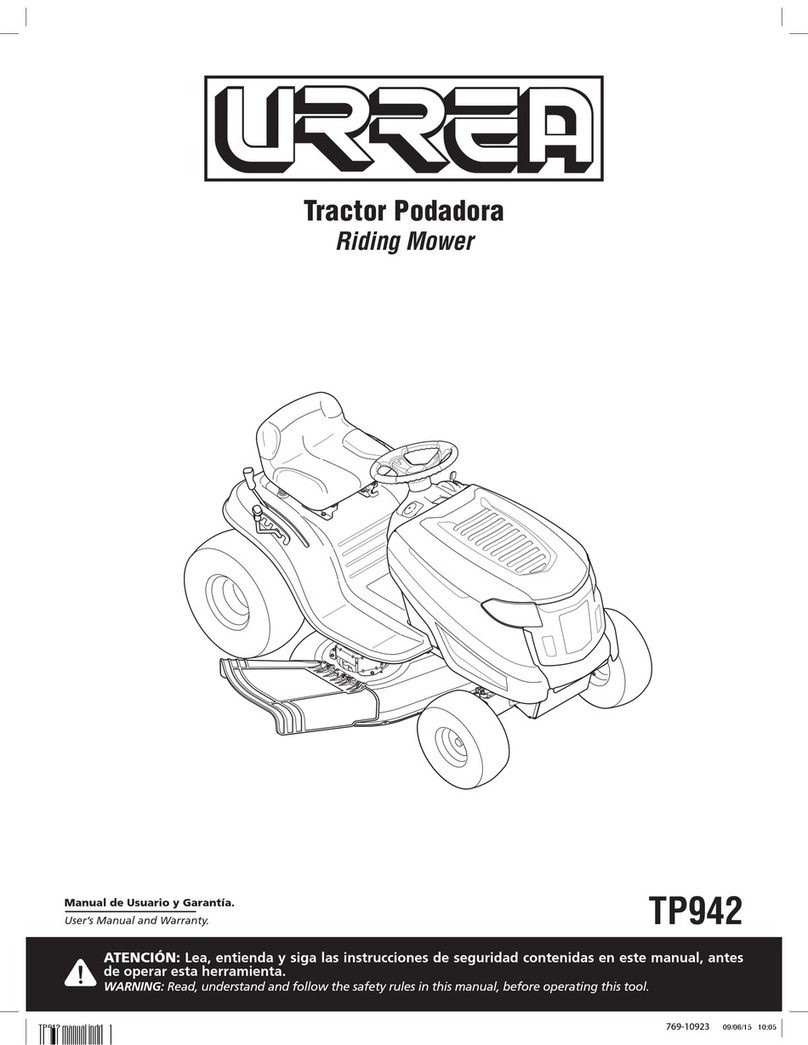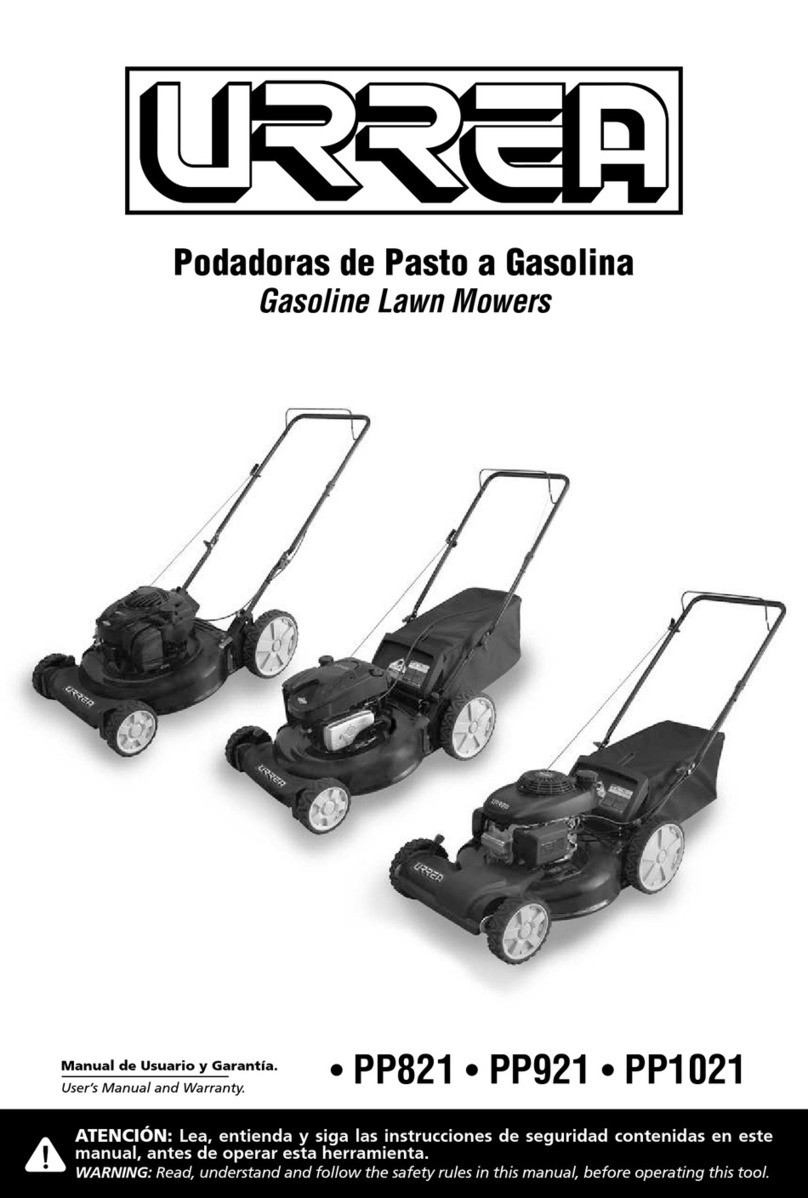
3
ESPAÑOL•Manual de usuario
NORMAS GENERALES DE SEGURIDAD
ADVERTENCIA: La presencia de este símbolo
indica que se trata de instrucciones importantes
de seguridad que se deben respetar para evi-
tar poner en peligro su seguridad personal y/o
material y la de otras personas. Lea y siga todas
las instrucciones de este manual antes de poner
en funcionamiento esta máquina. Si no respeta
estas instrucciones puede provocar lesiones per-
sonales.
OPERACIÓN EN GENERAL
1. Lea y siga todas las instrucciones contenidas
en este manual antes de intentar ensamblar esta
máquina. Lea, comprenda y siga todas las ins-
trucciones que figuran en la máquina y en el o
los manuales antes de intentar operarla.
2. Familiarícese completamente con los contro-
les y con el uso apropiado de esta máquina an-
tes de operarla. Guarde este manual en un lugar
seguro para referencias futuras y regulares.
3. Esta máquina es una pieza de equipo de pre-
cisión, por tanto, tenga precaución en todo mo-
mento. Su unidad ha sido diseñada para realizar
una tarea: cortar el pasto. No la utilice en nin-
gún otro propósito.
4. No permita que niños menores de 14 años
operen esta máquina. Los niños de 14 años o
más deben leer y comprender las instrucciones
contenidas en este manual y deben ser capacita-
dos y supervisados por uno de los padres.
5. No encienda el motor en espacios cerrados,
peligrosos gases de monóxido de carbono pue-
den acumularse.
6. Pode solamente durante el día o con una bue-
na iluminación artificial.
7. Evite operar el equipo en pasto mojado.
8. Preste atención al terreno para evitar trope-
zar.
5. Camine, nunca corra.
9. Para podadoras con ruedas, si trabaja en pen-
dientes, pode de lado a lado, nunca de arriba
hacia debajo de la pendiente o viceversa.
10. Tenga extrema precaución cuando cambie
de dirección en las pendientes.
11. No pode en pendientes excesivamente incli-
nadas.
12. Tenga extrema precaución cuando retroceda
o jale la podadora hacia usted.
13. Detenga la cuchilla si la podadora ha de ser
transportada a otro lugar y tenga que pasar so-
bre una superficie que no sea pasto.
14. Nunca opere una podadora con cubiertas
de protección defectuosas, o sin dispositivos de
seguridad, por ejemplo, deflectores o colectores
de césped en su lugar.
15. No cambie la configuración del motor ni tra-
te de exceder la velocidad de la máquina.
16. Desenganche todas las cuchillas y embragues
antes de arrancar el motor.
17. Arranque el motor cuidadosamente de
acuerdo a las instrucciones y con los pies lo sufi-
cientemente lejos de las cuchillas.
18. No incline la podadora cuando arranque el
motor a menos que sea necesario, en este caso,
no la incline más de lo necesario y levante solo
la parte que esté lejos del operador.
19. No arranque el motor cuando esté enfrente
del canal de descarga.
20. No acerque sus extremidades a las partes gi-
ratorias de la máquina.
21. Manténgase alejado de las aperturas de des-
carga.
22. Apague el motor y desconecte el cable de la
bujía, asegúrese de que todas las partes móviles
se hayan detenido completamente y remueva
cualquier llave ajustada:
-Antes de limpiar para desatascar el canal.
- Antes de revisar, limpiar o trabajar en la po-
dadora.
- Después de golpear un objeto extraño. Ins-
peccione la máquina, si encuentra daños estos
deben ser reparados antes de operarla nueva-
mente.
- Si la podadora comienza a vibrar de manera
anormal (verifíquela inmediatamente).
- Siempre que vaya a dejar la podadora.
- Antes de recargar el tanque de combustible.
23. Reduzca el ajuste del acelerador durante el
apagado del motor.
24. Vaya despacio cuando use un asiento trase-
ro.
FUNCIONAMIENTO EN PENDIENTES
Las pendientes son un factor importante que
se relaciona con los accidentes producidos por
deslices y caídas y que pueden producir lesiones
graves. La operación en pendientes requiere
mayor precaución. Si no se siente seguro en una
pendiente, no la pode. Para seguridad, use el
medidor de pendientes que se incluye como par-
te de este manual para medir la pendiente antes
de operar la unidad en una zona inclinada. Si la
pendiente supera los 15 grados, no la pode.
Haga lo siguiente:
1. Mueva la podadora a través de las caras de
la pendiente, nunca hacia arriba y abajo. Ten-
ga cuidado cuando cambie de dirección cuando
opere la máquina en pendientes.
2. Esté atento a los agujeros, raíces, rocas, ob-
jetos ocultos o abultamientos que puedan pro-
vocar que se derrape o se tropiece. El pasto alto































